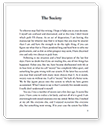Attention Deficit Disorder Essays and Research Papers
Instructions for Attention Deficit Disorder College Essay Examples
Title: This a literature review a literature review written summarize synthesize peoples ideas perspectives a topic topic ADD Attention Deficit Disorder
Total Pages: 6 Words: 1829 Sources: 10 Citation Style: APA Document Type: Essay
Title: Attention Deficit Disorder
Total Pages: 4 Words: 1593 References: 0 Citation Style: MLA Document Type: Research Paper
Title: Attention Deficit Disorder and the
Total Pages: 4 Words: 1103 Works Cited: 0 Citation Style: APA Document Type: Essay
Title: mindfulness and martial arts
Total Pages: 40 Words: 14405 Bibliography: 40 Citation Style: MLA Document Type: Research Paper


